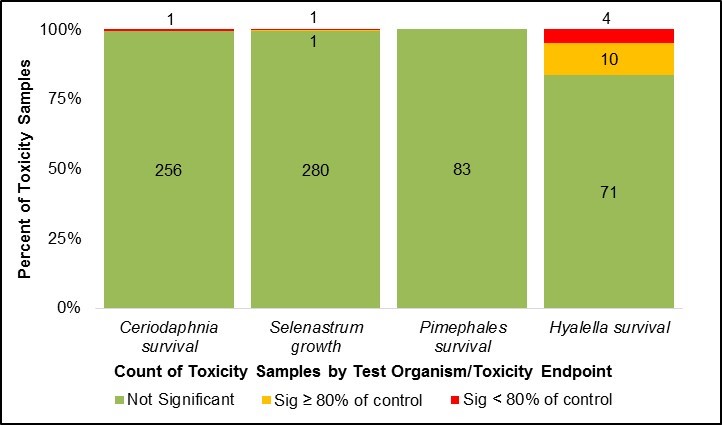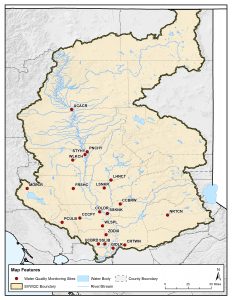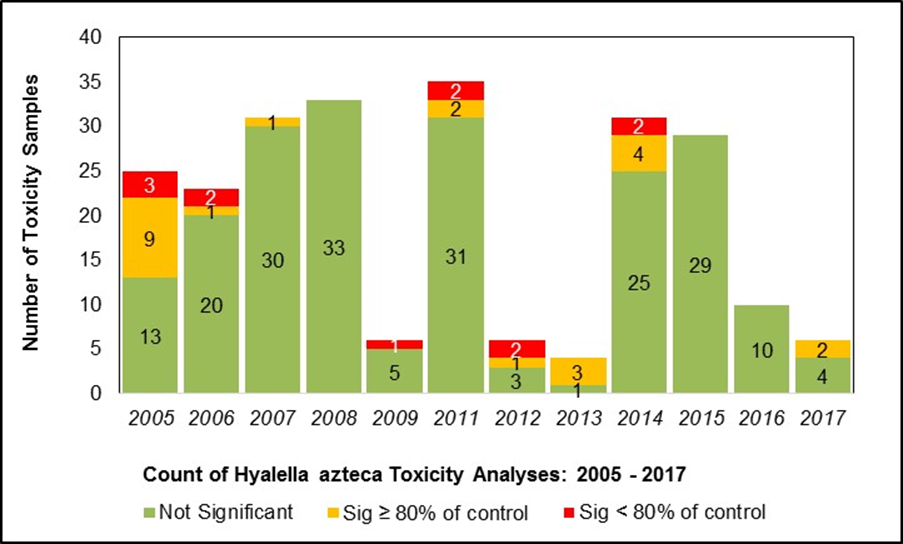Dr. Stephen L. Clark, Pacific EcoRisk and Michael Trouchon, Larry Walker Associates
Recent water quality monitoring testing conducted for the Sacramento Valley Water Quality Coalition (Coalition) show that water quality in the Sacramento Valley is good and particularly healthy for the aquatic ecosystem. Aquatic health and the biological condition of waterbodies is generally measured by toxicity testing for sensitive algae, invertebrates, and fish as shown in the following figure:

This figure above shows more than 700 water column and sediment samples collected and analyzed from 22 waterbodies (see map for monitoring locations) throughout the Sacramento Valley over the period 2012-2017. In summary, the figure shows:
- Very limited toxicity to Pimephales (fathead minnow) and Ceriodaphnia (water flea);
- Toxicity tests for Selenastrum capricornutum (a green alga) have shown the species to be doing well, with resilience in terms of cell density (cell counts per mL).
- Hyalella, a shrimp-like invertebrate that feeds on algae and diatoms and is a
 major food source for waterfowl along the Pacific Flyway, can tolerate alkaline waters and brackish waters, but cannot tolerate a pH lower (more acidic) than 6.0 standard units. Starting in 2011, Hyalella testing was linked to pyrethroids in sediments when toxicity to Hyalella is observed to be significant and shows an effect greater than (>) 80% of the control sample. Since 2011, 118 sediment samples have been tested with Hyalella–only six (6) have triggered the analysis of pyrethroids. Importantly, over a 12-year monitoring period, from 2005-2017, the proportion of samples with statistically significant toxicity, indicated in red and gold on the figure below, trended downward and has remained low in the last three years of monitoring. This included dry years such as 2015.
major food source for waterfowl along the Pacific Flyway, can tolerate alkaline waters and brackish waters, but cannot tolerate a pH lower (more acidic) than 6.0 standard units. Starting in 2011, Hyalella testing was linked to pyrethroids in sediments when toxicity to Hyalella is observed to be significant and shows an effect greater than (>) 80% of the control sample. Since 2011, 118 sediment samples have been tested with Hyalella–only six (6) have triggered the analysis of pyrethroids. Importantly, over a 12-year monitoring period, from 2005-2017, the proportion of samples with statistically significant toxicity, indicated in red and gold on the figure below, trended downward and has remained low in the last three years of monitoring. This included dry years such as 2015.

Toxicity tests by certified laboratories are used in the Central Valley Regional Water Quality Control Board’s regulatory programs as a tool to evaluate potential effects on aquatic life beneficial uses under the Porter-Cologne Water Quality Control Act.
Water leaders in the Sacramento Valley watch the results from this testing closely as part of their sustainability objective to manage water and land uses for multiple beneficial uses (i.e., farms, fish, birds, cities and rural communities and recreation). In this case, the focus is on assuring that agronomic practices are protective of aquatic life beneficial uses of water that support fish, birds and wildlife. Here, the results suggest that the management practices used by the 8300 owners and operators of irrigated agriculture are generally working and continue to protect aquatic ecosystems that are important to fish, birds and other wildlife. The results also indicate a healthy biological condition for these waterbodies, which generally support a wide variety and high number of macroinvertebrate taxa, including many that are critical for supporting fish and wildlife. In areas where there are noticeable detections, the local leaders will analyze the results with the Coalition’s scientists, try to identify the source of toxicity and then determine what actions upstream can rectify any problems.
For more information on this data and the program for improving water quality in the Sacramento Valley, please visit the Coalition’s website at www.svwqc.org
Dr. Clark has conducted extensive research for almost 30 years in aquatic ecotoxicology with an emphasis on the effects of contaminants on aquatic organisms at the whole organism/cellular/biochemical level (e.g., “biomarkers”). Michael Trouchon is a Senior Scientist with 23 years of experience in the water quality and water resources field, with recent assignments focused on management and coordination of a regional agricultural water quality monitoring program in the Sacramento Valley; wastewater NPDES permit and waste discharge requirements (WDR) compliance.



